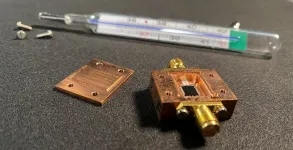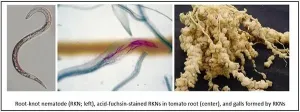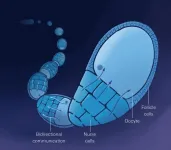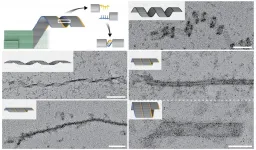(Press-News.org) Researchers at Chalmers University of Technology, Gothenburg, Sweden, have developed a novel type of thermometer that can simply and quickly measure temperatures during quantum calculations with extremely high accuracy. The breakthrough provides a benchmarking tool for quantum computing of great value - and opens up for experiments in the exciting field of quantum thermodynamics.
A key component in quantum computers are coaxial cables and waveguides - structures which guide waveforms, and act as the vital connection between the quantum processor, and the classical electronics which control it. Microwave pulses travel along the waveguides to the quantum processor, and are cooled down to extremely low temperatures along the way. The waveguide also attenuates and filters the pulses, enabling the extremely sensitive quantum computer to work with stable quantum states.
In order to have maximum control over this mechanism, the researchers need to be sure that these waveguides are not carrying noise due to thermal motion of electrons on top of the pulses that they send. In other words, they have to measure the temperature of the electromagnetic fields at the cold end of the microwave waveguides, the point where the controlling pulses are delivered to the computer's qubits. Working at the lowest possible temperature minimises the risk of introducing errors in the qubits.
Until now, researchers have only been able to measure this temperature indirectly, with relatively large delay. Now, with the Chalmers researchers' novel thermometer, very low temperatures can be measured directly at the receiving end of the waveguide - very accurately and with extremely high time resolution.
"Our thermometer is a superconducting circuit, directly connected to the end of the waveguide being measured. It is relatively simple - and probably the world's fastest and most sensitive thermometer for this particular purpose at the millikelvin scale", says Simone Gasparinetti, Assistant Professor at the Quantum Technology Laboratory, Chalmers University of Technology.
Important for measuring quantum computer performance
The researchers at the Wallenberg Centre for Quantum Technology, WACQT, have the goal to build a quantum computer - based on superconducting circuits - with at least 100 well-functioning qubits, performing correct calculations by 2030. It requires a processor working temperature close to absolute zero, ideally down to 10 millikelvin. The new thermometer gives the researchers an important tool for measuring how good their systems are and what shortcomings exist - a necessary step to be able to refine the technology and achieve their goal.
"A certain temperature corresponds to a given number of thermal photons, and that number decreases exponentially with temperature. If we succeed in lowering the temperature at the end where the waveguide meets the qubit to 10 millikelvin, the risk of errors in our qubits is reduced drastically", says Per Delsing, Professor at the Department of Microtechnology and Nanoscience, Chalmers University of Technology, and leader of WACQT.
Accurate temperature measurement is also necessary for suppliers who need to be able to guarantee the quality of their components, for example cables that are used to handle signals down to quantum states.
New opportunities in the field of quantum thermodynamics
Quantum mechanical phenomena such as superposition, entanglement and decoherence mean a revolution not only for future computing but potentially also in thermodynamics. It may well be that the thermodynamic laws somehow change when working down at the nanoscale, in a way that could one day be exploited to produce more powerful engines, faster-charging batteries, and more.
"For 15-20 years, people have studied how the laws of thermodynamics might be modified by quantum phenomena, but the search for a genuine quantum advantage in thermodynamics is still open", says Simone Gasparinetti, who recently started his own research group and plans to contribute to this search with a novel range of experiments.
The new thermometer can, for example, measure the scattering of thermal microwaves from a circuit acting as a quantum heat engine or refrigerator.
"Standard thermometers were fundamental for developing classical thermodynamics. We hope that maybe, in the future, our thermometer will be regarded as pivotal for developing quantum thermodynamics", says Marco Scigliuzzo, doctoral student at the Department of Microtechnology and Nanoscience, Chalmers University of Technology.
INFORMATION:
Read more in the scientific article in Physical Review X:
Primary Thermometry of Propagating Microwaves in the Quantum Regime
https://journals.aps.org/prx/abstract/10.1103/PhysRevX.10.041054
More about: How the primary thermometer works
The novel thermometer concept relies on the interplay between coherent and incoherent scattering from a quantum emitter driven at resonance. The emitter is strongly coupled to the end of the waveguide being tested. Thermal photons in the waveguide lead to a measurable drop in the coherently scattered signal, which is recorded continuously. In this way, the number of photons in the propagating mode of the microwave waveguides can be read - this corresponds to a temperature. The Chalmers researchers' implementation, which uses a superconducting circuit operated at gigahertz frequencies, offers simplicity, large bandwidth, high sensitivity, and negligible power dissipation.
More about: The Wallenberg Centre for Quantum Technology
The Wallenberg Centre for Quantum Technology, WACQT, is a 12 year research center that aims to take Sweden to the forefront of quantum technology. The main project is to develop an advanced quantum computer. WACQT is coordinated from Chalmers University of Technology, and has activities also at the Royal Institute of Technology, Lund University, Stockholm University, Linköping University and Göteborg University.
http://www.wacqt.se/
Incorporating Black churches and clergy in COVID-19 vaccination education and distribution has been found to be an effective model in helping to increase vaccination delivery to historically at-risk populations in San Bernardino County, a study says.
Focused education efforts and an on-site mobile clinic in Black church parking lots resulted in the vaccinations of 417 people, 84% of whom were Black. The study also found an increase in Black attendance of mass vaccination clinics to 3.6% of total patients, up from 3%, in the week post-initiative.
Researchers at Loma Linda University School of Pharmacy published their findings on March 10 in The Lancet Global Health, ...
Almost 90 percent of infectious travelers could be detected with rapid SARS-CoV-2 tests at the airport, and most imported infections could be prevented with a combination of pre-travel testing and a five-day post-travel quarantine that would only lift with a negative test result, according to a computer simulation by UC San Francisco researchers.
The study offers much-needed data to airlines and states that have struggled through a year of the pandemic with little guidance on how to enable safe travel.
The issue is becoming more pressing as states ...
Root-knot nematodes (RKNs, Meloidogyne spp.) infect a broad range of plants, including several agriculturally important species such as cotton, soybean and corn, as well as various vegetables and ornamentals. These parasites cause roots to develop galls that result in severe plant damage and, ultimately, important crop losses. Growers currently use synthetic nematicides to manage RKNs; however, these compounds are detrimental to the microbial diversity of soil and harmful for the environment. Thus, it is necessary to develop alternative sustainable control methods.
"We have been seeking natural compounds that activate plant defense ...
A team of scientists at the University of Massachusetts Amherst have developed the thinnest and most sensitive flow sensor, which could have significant implications for medical research and applications, according to new research published recently in Nature Communications.
The research was led by Jinglei Ping, assistant professor of mechanical and industrial engineering, along with a trio of mechanical engineering Ph.D. students: Xiaoyu Zhang, who fabricated the sensor and made the measurement, Eric Chia and Xiao Fan. The findings pave the way for future research on all-electronic, in-vivo flow monitoring in investigating ...
A cast of so-called 'nurse cells' surrounds and supports the growing fruit fly egg during development, supplying the egg -- or 'oocyte' -- with all the nutrients and molecules it needs to thrive. Long viewed as passive in this process, the Drosophila egg actually plays an active role not only in its own growth, but also in the growth of the surrounding nurse cells, Princeton University researchers report on March 21 in Developmental Cell.
"Here we show an example of bidirectional communication -- a dialogue -- between different cells. The egg is taking an active hand in controlling its own feeding ...
Scientists from the Department of Physiology of the University of Granada (UGR) have shown that caffeine (about 3 mg/kg, the equivalent of a strong coffee) ingested half an hour before aerobic exercise significantly increases the rate of fat-burning. They also found that if the exercise is performed in the afternoon, the effects of the caffeine are more marked than in the morning.
In their study, published in the Journal of the International Society of Sports Nutrition, the researchers aimed to determine whether caffeine--one of the most commonly-consumed ergogenic substances in ...
LAWRENCE -- When a franchise buys a superstar like Tom Brady or LeBron James, the team tends to win more games. But do the fans follow? How much team loyalty is purchased along with an expensive star? Maybe not as much as some owners might hope -- in the NBA Finals between the Miami Heat and San Antonio Spurs, many fans expressed their dislike of the "bought" Miami team.
In a new paper published in the peer-reviewed Journal of Applied Social Psychology, researchers at the University of Kansas asked over 1,500 Americans how much they liked teams that purchased excellence and compared that with liking teams that built excellence from the ground up.
"People reliably ...
An international team of scientists from Nanyang Technological University, Singapore (NTU Singapore), Brown University and the Massachusetts Institute of Technology (MIT) has developed an artificial intelligence (AI) platform that could one day be used in a system to assess vascular diseases, which are characterised by the abnormal condition of blood vessels.
The AI-powered platform combines machine learning and a specially-designed microfluidic chip with analysis of 2D video images of blood flow and the application of physical laws, to infer how blood flows in 3D. In tests, it accurately predicted blood flow characteristics such as speed, pressure, and shear stress, ...
The world needs more electricity. As populations grow, standards of living increase and more people gain access to modern conveniences, countries will need to expand their energy generation capacity.
India, with its rapidly developing economy and a population of more than 1.3 billion, epitomizes this trend. The country finds itself at a crossroads regarding its energy future: Small decisions today will resound in the coming years.
In their latest report, the Indian government set a target of 450 gigawatts of renewable energy capacity by 2030. For comparison, the country's total energy generation capacity today is about 380 gigawatts, out of which 90 gigawatts are of renewable energy, not including large hydropower stations. How this plan shapes up will dictate how ...
(BOSTON) -- A team of nanobiotechnologists at Harvard's Wyss Institute for Biologically Inspired Engineering and the Dana-Farber Cancer Institute (DFCI) led by Wyss Founding Core Faculty member William Shih, Ph.D., has devised a programmable DNA self-assembly strategy that solves the key challenge of robust nucleation control and paves the way for applications such as ultrasensitive diagnostic biomarker detection and scalable fabrication of micrometer-sized structures with nanometer-sized features. Using the method, called "crisscross polymerization", the researchers can initiate weaving ...





